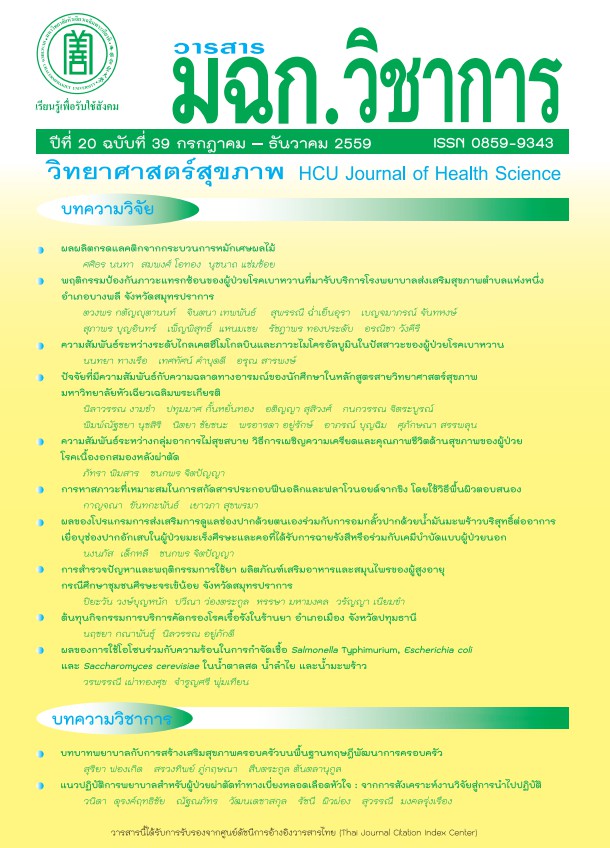Optimization of Total Phenolics and Flavonoids from Ginger Using Response Surface Methodology
Keywords:
Ginger, phenolics, avonoids, response surface methodologyAbstract
This research aimed to study optimal conditions for solvent extraction of total phenolics, flavonoids and antioxidant activities from ginger (Zingiber officinale). Response surface methodology, Box Behnken design was applied for the experimental design to investigate the optimal conditions. Ranges of operating conditions including chosen as follow: 40-80 %v/v aqueous ethanol concentrations, 30-60°C extraction temperature and 3-6 hours extraction time were chosen. The results from ginger extractions were a) the optimal conditions for extraction of phenolics was 77 %v/v aqueous ethanol concentrations, 60°C extraction temperature and 4.2 hours extraction time, b) the extraction of flavoniods was 80 %v/v aqueous ethanol concentrations, 40°C extraction temperature and 3 hours extraction time and C) the antioxidant activity was 74 %v/v aqueous ethanol concentrations, 49°C extraction temperature and 6 hours extraction time. The maximum contents of the total phenolics, flavoniods and antioxidant activity obtained the optimal conditions were 2.23 % (r2 = 0.93), 2.19 % (r2 = 0.99), and 62.52% (r2 = 0.91), respectively. According to the response surface, the ethanol concentration was a significant factor for the total phenolics extraction. However, for flavonoids and antioxidant activities, the ethanol concentration and temperature were the significant factors.
Downloads
References
วิทยาศาสตร์เกษตร. 40 : (1 พิเศษ) หน้า 83-86.
ถนอมศรี วงศ์รัตนาสถิต. (2538) ตำราเอกลักษณ์สมุนไพร. กรุงเทพมหานคร : ภาควิชาเภสัชวินิจฉัย คณะเภสัชศาสตร์. มหาวิทยาลัยมหิดล.
Box, G. E. P. and Behnken, D. W. (1960) “Some new three level designs for the study of quantitative variables” Technometrics. 2 page 455-475.
Esam, H. M. and Ali, H. K. (2000) “Evaluation of antioxidant of some plant extracts and their application to ground beef patties” J. Food Chemistry. (69) page 135-141.
Ghasemzadeh, A., Jaafar, H. and Rahmat A. (2011) “Effects of solvent type on phenolics and flavonoids content and antioxidant activities in two varieties of young ginger
(Zingiber officinale Roscoe) extracts” J. Medicinal Plants Research. 5 (7) page 1147-1154.
Habsah, M. et al. (2000) “Screening of Zingiberaceae extracts for antimicrobial and antioxidant activities” J. Ethnopharmacology. 72 page 403-410.
Liu, Z. L. and Ho, S. H. (1999) “Bioactivity of the essential oil extracted from Evodia rutaecarpa Hook f. et Thomas against the grain storage insects, Sitophilus
zeamais Motsch. And Tribolium castaneum (Herbst)” J. Stored Products Research. 35 page 317-328.
Nguefack, J. et al. (2004) “Evaluation of five essential oil fromaromatic plant of Cameroon for controlling food spoilage and mycotoxin producing fungi” International
Journal of Food Microbiology. 94 page 329-334.
Zaeoung, S., A Plubrukarn and N. Keawpradub. (2005) “Cytotoxic and free radical scavenging activities of Zingiberaceous rhizomes” J. Songklanakarin Sci. Technol. 27(4) page 799-812.
Downloads
Published
How to Cite
Issue
Section
License
บทความที่ได้รับการตีพิมพ์เป็นลิขสิทธิ์ของวารสารวิทยาศาสตร์สุขภาพและสุขภาวะ
ข้อความที่ปรากฏในบทความแต่ละเรื่องในวารสารวิชาการเล่มนี้เป็นความคิดเห็นส่วนตัวของผู้เขียนแต่ละท่านไม่เกี่ยวข้องกับมหาวิทยาลัยหัวเฉียวเฉลิมพระเกียรติ และคณาจารย์ท่านอื่นๆในมหาวิทยาลัยฯ แต่อย่างใด ความรับผิดชอบองค์ประกอบทั้งหมดของบทความแต่ละเรื่องเป็นของผู้เขียนแต่ละท่าน หากมีความผิดพลาดใดๆ ผู้เขียนแต่ละท่านจะรับผิดชอบบทความของตนเองแต่ผู้เดียว




